

28 Awesome STEM Challenges for the Elementary Classroom. Ever wonder what STEM challenges to serve up to your students?

Here is an amazing list of clever, unique and simple set up STEM lesson plans from other teachers. You’re going to love what your students come up with and the number of standards you can meet with these. There is a range of grade level ideas K-5 in this list. 40 STEM Activities for Kids. Activities for ages 4 and up.
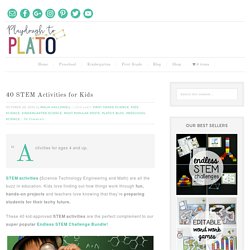
STEM activities (Science Technology Engineering and Math) are all the buzz in education. Kids love finding out how things work through fun, hands-on projects and teachers love knowing that they’re preparing students for their techy future. These 40 kid-approved STEM activities are the perfect complement to our super popular Endless STEM Challenge Bundle! How to Make Magnetic Slime - Frugal Fun For Boys and Girls. STEM Straw Bridges. Activity for ages 5 to 8.
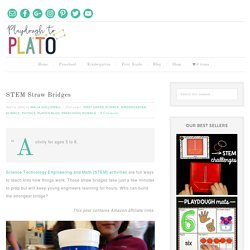
Science Technology Engineering and Math {STEM} activities are fun ways to teach kids how things work. These straw bridges take just a few minutes to prep but will keep young engineers learning for hours. Who can build the strongest bridge? MarylandStateSTEMStandardsofPracticeFrameworkGrades6 12. STEM Education Grades 6-8 ~ Instruction ~ School Improvement in Maryland. STEM Proficient Students: STEM proficient students are able to answer complex questions, investigate global issues, and develop solutions for challenges and real-world problems while applying the rigor of science, technology, engineering, and mathematics content.

STEM proficient students are logical thinkers who are technologically, scientifically, and mathematically literate. STEM Education in Middle School STEM education in middle school builds upon the foundational skills developed by students throughout elementary school. STEM Education Grades K-5 ~ Instruction ~ School Improvement in Maryland. STEM Proficient Students: STEM proficient students are able to answer complex questions, investigate global issues, and develop solutions for challenges and real-world problems while applying the rigor of science, technology, engineering, and mathematics content.
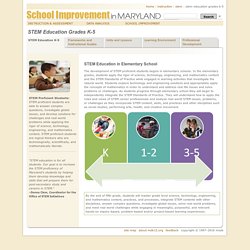
STEM proficient students are logical thinkers who are technologically, scientifically, and mathematically literate. STEM Education in Elementary School The development of STEM proficient students begins in elementary schools. In the elementary grades, students apply the rigor of science, technology, engineering, and mathematics content and the STEM Standards of Practice while engaged in learning activities that investigate the natural world. PBS LearningMedia. Bayer compendium. How to Engineer a Great STEM Curriculum for Middle School.
A MiddleWeb Blog What does a good middle school STEM curriculum look like?
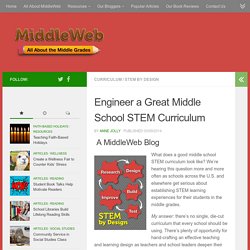
We’re hearing this question more and more often as schools across the U.S. and elsewhere get serious about establishing STEM learning experiences for their students in the middle grades. My answer: there’s no single, die-cut curriculum that every school should be using. There’s plenty of opportunity for hand-crafting an effective teaching and learning design as teachers and school leaders deepen their discussion about “what we want our STEM program to look like and accomplish.” I imagine this deeper discussion might include these probing questions: EDU STEAMGuide V1 5. STEM (Science, Technology, Engineering, Math) Hopkins Public Schools has integrated STEM (Science, Technology, Engineering and Math) into its elementary, junior high and high school core curriculum.
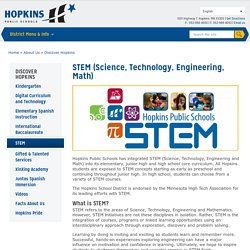
All Hopkins students are exposed to STEM concepts starting as early as preschool and continuing throughout junior high. In high school, students can choose from a variety of STEM courses. The Hopkins School District is endorsed by the Minnesota High Tech Association for its leading efforts with STEM. What is STEM? Home. The Ultimate STEM Guide for Kids: 239 Cool Sites. STEM Education in the Elementary Classroom. In order to meet the increasingly rigorous and technically focused demands of 21st century living, we have seen quite a push in American society to engage our youth in STEM education (Science, Technology, Engineering, and Mathematics).

This comes on the heels of the alarmingly overall low performance of American high school students’ test scores in math and science compared to other industrialized countries. President Obama has stated many times that we as a nation must remain leaders in science and technology, as our national economic prosperity depends on it. When we think of STEM education, we think high school students taking chemistry and algebra courses, not third graders and multiplication. Improving STEM Curriculum and Instruction: Engaging Students and Raising Standards. Download the full brief The glazed eyes, the hands propping up heads, the giggling in the back of the room: these are the all-too-common signs of disengaged students in STEM classes across the country.
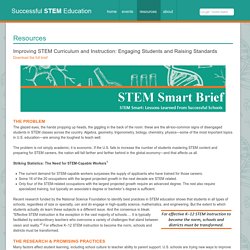
Algebra, geometry, trigonometry, biology, chemistry, physics—some of the most important topics in U.S. education—are among the toughest to teach well. The problem is not simply academic; it is economic. If the U.S. fails to increase the number of students mastering STEM content and preparing for STEM careers, the nation will fall farther and farther behind in the global economy—and that affects us all. Striking Statistics: The Need for STEM-Capable Workers1. STEM for Elementary School Students - How to Instill a Lifelong Love of Science. Elementary STEM students at Glen Lake Elementary in Minnetonka, MN (Photo Credit: Glen Lake Schools) By now, we’ve all heard about STEM (science, technology, engineering, mathematics) — and its importance to the U.S. economy.
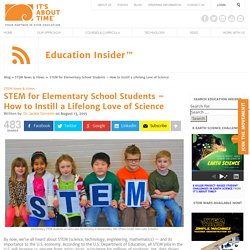
According to the U.S. Department of Education, all STEM jobs in the U.S. will increase 14 percent from 2010-2020, accounting for millions of positions. Yet, data shows that 3 million of those jobs will go unfilled by 2018. STEM Curriculum. Hopkins Public Schools is going beyond the core curriculum to offer students an education that prepares them to compete globally using 21st century skills. What is STEM? STEM refers to the areas of Science, Technology, Engineering and Mathematics. However, STEM initiatives are not science, technology, engineering and mathematics in isolation.
STEM Resources. By Phil Nast, retired middle school teacher and freelance writer Found In: mathematics, science, preK-2, 3-5, 6-8, 9-12 Curriculum Resources Exploratorium Provides interactives, web features, activities, programs, and events for K-12. Saturday and Summer professional development workshops are available through the Teacher Institute. STEM: It's Elementary! Expert advice on effective STEM education for elementary school teachers by Erin MacPherson Picture a first-grade classroom, maybe even your own.
Kids gather around the sand table, exploring the sand, letting the grains run between their fingers. The teacher passes out some props—marbles, rulers, boxes and cups—and lets students explore freely for a few minutes. The kids excitedly dig in, filling cups with sand and pouring it out, burying marbles, and turning the rulers into shovels and rakes. Stem curriculum elementary. STEM School - Resource for STEM Education. What is STEM Education? STEM is a curriculum based on the idea of educating students in four specific disciplines — science, technology, engineering and mathematics — in an interdisciplinary and applied approach. Rather than teach the four disciplines as separate and discrete subjects, STEM integrates them into a cohesive learning paradigm based on real-world applications.
Though the United States has historically been a leader in these fields, fewer students have been focusing on these topics recently. According to the U.S. The lowdown on STEM schools. A high school student tosses a ball into the air and watches it fall. Then he films the falling ball and graphs the movement on his computer. Nearby, a sophomore scrawls out equations with a blue marker, while a classmate looks over his shoulder and shakes her head. Starting and Implementing a STEM Program - Arizona STEM Network by Science Foundation Arizona. How to Get Your School Ready for STEM This Year. Home. Starting and Implementing a STEM Program - Arizona STEM Network by Science Foundation Arizona. Science, Technology, Engineering and Math: Education for Global Leadership.